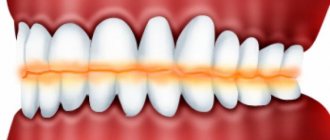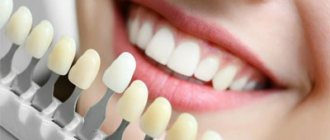Why are teeth drilled?
In dentists' language, drilling teeth means preparing. The doctor removes tooth tissue damaged by caries before placing a filling. However, teeth are drilled not only for treatment.
The tooth may be prepared to be covered with a crown. Prosthetics are needed if the doctor sees that restoring a tooth with a filling is unreliable. For example, when it is a front tooth and there is a risk of chipping due to increased load. Another reason is the small volume of healthy tissue. If the patient has deep caries, and even more so pulpitis, tooth restoration with a crown is indicated. In this case, the dentist drills the tooth in several stages. The doctor dissects it to remove caries-affected tissue to open the pulp chamber, gain access to the canals and widen them. At the last stage, after removing the nerve and treatment, the dentist drills the tooth, grinding it down for a crown.
The doctor is sometimes forced to dissect even healthy (without caries) and living (with nerve) teeth. This happens when veneers are placed. They are ceramic overlays for teeth. It happens that the front teeth are too small or there are large distances between them. It happens that a spot appears on a tooth due to fluorosis, enamel hypoplasia, or trauma. Sometimes a small part of the front tooth breaks off or the cutting edge wears off. There are simply very demanding patients when it comes to aesthetics. They want their front teeth to be the same shape, size and perfect appearance. In all these cases, installation of veneers is possible. Their advantage is that the tooth remains alive. It is not depulped and a small layer of enamel is removed (ground down).
Treatment of caries
1 - here you can see darkening between two teeth, the patient noted that the thread got stuck between them; 2 - due to poor polishing of the filling border, caries recurrence occurred; 3 - the filling itself had completely fallen out, the same “hole” in the tooth that forced the patient to see a dentist... she had no idea about the existence of problems with the neighboring teeth
So, the problem has been identified, the need to visit the dentist has become obvious to you. You have taken some time to carefully select a dentist. Now you need to understand whether the doctor you have chosen really works in line with modern standards.
Let's consider the main stages of treatment, their sequence and the time required to properly complete them.
1. Pain relief (2-15 min).
There's probably no need for any special explanation here. Modern anesthetics are supplied ready-made in carpules and the procedure is performed with a special carpule syringe. This is perhaps the only somewhat unpleasant manipulation. And even then, with the help of special preparations in the form of a gel or spray, you can first numb the mucous membrane at the injection site. Depending on the tooth, the wait for the drug to take effect after the injection may vary. From 1-2 minutes in the case of any upper as well as lower front teeth, and up to 15-20 minutes in the case of the lower lateral teeth.
2. Cleaning the tooth from plaque (1 min)
Before starting treatment, the surface of the problem tooth should be cleaned with a paste and brush. If the patient has plaque, sub- and supragingival dental deposits, then even before treating caries, he should undergo professional cleaning of the oral cavity.
3. Tooth isolation (2-5 min)
By modern standards, this stage is very important, especially when working with light composites (in most cases today doctors use them), and the service life of the restoration largely depends on it. Composite materials are very sensitive to moisture (blood, saliva and even moisture from the patient’s breath), so its penetration onto the surface being restored is unacceptable. At the same time, many doctors still continue to use cotton rollers to isolate the working tooth, as they did many years ago. I will not categorically say that this cannot be done, but this method is already a thing of the past and in many cases is insufficient for high-quality long-term isolation.
The rubber dam allows the dentist to completely isolate the working area from the rest of the oral cavity. Moreover, during treatment the patient can even cover his mouth without the risk of saliva getting into the working area
Problem teeth are isolated using a rubber dam as reliably as possible from saliva, blood and even moisture from the patient’s breath
4. Tooth preparation (2-10 min)
The time in this case is determined by which tooth needs treatment, how convenient it is to access it, as well as the size and location of the carious cavity. What can the patient note for himself at this stage? The doctor must treat the tooth intermittently (i.e., do not “drill” the tooth without lifting the bur from it), always with powerful water cooling. Accordingly, in modern conditions the patient does not spit out anything every second, and all water is removed with a saliva ejector and a vacuum cleaner. Unfortunately, there are still doctors everywhere who work without water cooling. This habit sometimes remains especially true among doctors of the old Soviet school, who are accustomed to working on old types of dental units. Such luxury as water was not provided in them, and the oral cavity was sprayed, at best, once at the end with water from a syringe or enema. After which the patients, each to the best of their accuracy, spat it all into the spittoon - very unhygienic and inconvenient. Thank God, times have changed, although not everyone can keep up with it. And if installations without water are already difficult to find even in district clinics, then judging by what I saw, there are plenty of doctors who turn off the water specifically for the sake of their “convenience.” Why is it so important that the tooth is well cooled during preparation? Any living tissue suffers from overheating, which occurs when the boron rubs against hard tissue. And if this elevated temperature is not quickly removed by a water-air flow, then the overheated tooth pulp will soon greet you in the form of inflammation - pulpitis. And the need will come to remove it, i.e. very expensive root canal treatment.
“Any living tissue suffers from overheating”...
Lack of cooling can lead to unpleasant health consequences
In addition, highly infected dust generated during tooth preparation without water is inhaled by both the patient and the staff (even despite masks). You understand that breathing this “air cocktail” is not very useful, especially for people with chronic respiratory diseases, asthmatics, etc. And besides, after flying a little, this dust, as it should be by the laws of physics, settles on everything in the office. Including what the doctor and assistant handle during the appointment, which means the risk of cross-infection of patients increases. Unless you do a wet general cleaning after each patient, which, you see, is out of the realm of fantasy.
So now, when entering a clinic or office, if you smell the smell of “scorched teeth” that is so familiar to visitors to regional clinics, then you can safely turn 180 degrees. Nothing good awaits you there for sure.
5. Treatment of the prepared cavity with antiseptics (30 sec)
In general, I wouldn’t even stop at this point, because it’s unlikely that you will be able to understand anything here or even notice this stage. The main thing is that the doctor, having barely taken the burr out of his hands, does not immediately begin to stuff filling material into the cavity. Unfortunately, I also saw this when, while still a student in practice, I had to plunge into the everyday life of district clinics. Moreover, the indelibility of this impression of mine over time is also due to the fact that the doctor was working without cooling. At the same time, he didn’t even bother to wash off the dust from the tooth with water, and immediately began to wall up the dirt in it with cement, which I had just lovingly and according to all the rules mixed in with. So, in general, I became acquainted with the realities of free and affordable dentistry.
6. Adhesive cavity preparation (2-3 min)
What's the clever term in the name of the stage? Yes, in general, everything is simple. All modern filling materials are “glued” to the tooth with a special “glue” - an adhesive (or bond). It is he who holds the filling in the cavity. To increase the bonding surface, concentrated acid is first applied to the tooth. It creates micro-roughness on the enamel surface. And then the doctor uses a brush to introduce adhesive into the tooth cavity. If you have not had a rubber dam installed, then when washed off the tooth, acid residues may enter your mouth and you will feel a sour taste. I have also seen how some doctors, after washing off the acid, asked the patient to spit out the “sour water” on their own. Everything would be fine, but under no circumstances should the surface of the tooth come into contact with saliva after treatment with acid. Otherwise, the whole meaning of the procedure is lost, and the technology is thus grossly violated.
After treating the tooth with acid, the same “glue” - adhesive - is introduced into it with a brush and illuminated with a light lamp.
This is what the “glue” looks like for composite restorations from various manufacturers
7. Adding filling material (5-40 min)
This is the longest and most difficult stage. It requires from the doctor not only mechanical skills, but also artistic skills in order to recreate a close-to-natural shape and color during aesthetic tooth restoration. These skills acquire particular importance when working with the anterior group of teeth, which, for obvious reasons, have a special aesthetic significance. Therefore, the time spent by the doctor on this stage can vary greatly, depending on the size and shape of the cavity, and on the meticulousness with which the doctor approaches recreating the shape and color.
What can the patient notice, and what is important to know about this stage?
The filling material is introduced into the cavity in small portions, each of which should be illuminated with a lamp for 10 to 40 seconds. Those. This is a rather labor-intensive and time-consuming process if you follow the rules. Some doctors don’t bother much, and even if there is nothing left of the tooth, they cook it completely from 2-3 “pieces” of material. This is a gross violation of technology, and it will certainly affect the service life of such a restoration. I had to deal with the fact that some patients interpret this moment in their own way, with the exact opposite meaning. They say that one doctor was digging into something for a long time and tediously, which means he is inexperienced, inept, his hand is not full, but another doctor quickly did everything for me in two or three movements - and the tooth is like new, a real pro! I think there is no need to explain now that this interpretation is fundamentally erroneous.
If caries has affected the contact surface of the tooth (this is the surface in contact with the adjacent tooth in the dentition), then the doctor must install special separating devices (matrices) before adding the filling material so that the filling material does not stick to the neighboring tooth and does not hang between the teeth above the gum. More than once, unfortunately, I have seen just such fillings placed as a single “monolith” on 2 teeth and squeezing the gums between them. After treatment is completed, this point can be easily checked by trying to pass dental floss into contact between two teeth. The thread should pass with little effort and a slight click at the point of contact of the teeth, without fibering, getting stuck or tearing. If this happens, or it does not fit between the teeth at all, it is a defect. Such a restoration must be modified or completely redone. It is also bad if the thread “flies” without any delay, i.e. There is no contact between the teeth. This means that food will get stuck there, causing gum inflammation.
Here you can see how, when working with the contact surface of the tooth being restored, a matrix (1) is installed, supported against the tooth with a wooden wedge (2) and a special ring (3) so that the filling material fits tightly to the tooth near the gum
8. Grinding and polishing of the restoration (approx. 10 min)
Also an equally important step, which some doctors almost completely ignore. And the service life of the previously done work largely depends on the thoroughness of its implementation.
Grinding of the restoration is done to remove all excess material, smooth out the boundaries of the restoration, and remove overhanging edges in the gum area. Sometimes, if the doctor “overdid it” when restoring a tooth, the grinding stage can take a long time, because the filling “interferes with the bite.”
As a small digression, I want to say that this is precisely the weak point of the technology for restoring teeth with composite materials directly in the mouth. Tooth restoration is virtually done by eye, especially if the tooth is severely damaged and anatomical landmarks are lost. In the middle of work, the doctor does not have the opportunity to ask the patient to close his teeth, move them in different directions, and thus orient himself as the work progresses. But a dental technician has such an opportunity when “fillings” (more correctly speaking, inlays) are made from ceramics or precious alloys in the laboratory on plaster models of the patient’s teeth obtained from impressions. But I will tell you more about this technology in another article.
So, there is no need to be shy if you feel uncomfortable closing your mouth and making other movements. Some patients, dreaming of jumping out of the chair as quickly as possible, or simply out of excessive modesty not wanting to burden the doctor, wave their hand: “Yes, everything is fine, it will rub itself in later.” You shouldn't do that. The consequences of overestimation can be very different, even quite serious and unpleasant. Therefore, in general, although the doctor usually asks whether it is comfortable for you to close your teeth and rub them, he must determine the degree of need for grinding himself, using objective methods. Basically, determining the point of excess contact occurs with the help of thin articulating paper, similar to carbon paper (due to poverty, some still use ordinary carbon paper). At the same time, this should not be a small piece for exactly one treated tooth, but strips for the entire dentition, and the doctor should place them on both sides, even where the teeth were not touched at all.
After finishing the grinding, the doctor must carefully polish the restoration to an almost mirror-like shine. Underpolishing, especially in places that are difficult to reach with a toothbrush, leads to increased accumulation of plaque and increases the risk of recurrent caries.
Ultimately, if the doctor performed this step well, you should not feel any joints between the filling and the tooth, the border should not be felt to the touch. The surface of the restoration must be absolutely smooth and free of roughness (just do not confuse this with the restored natural relief, for example, on a chewing tooth, where there are tubercles and “folds”-fissures).
This is only part of what is needed to grind and polish the filling. In this case, these are rubber and silicone heads with diamond chips
Diamond-coated paper discs of varying degrees of grain size are also often used.
Lavsan strips with abrasive coating of different grain sizes for treating contact surfaces of teeth
Polishing pastes, which, as a rule, end the whole process. Moreover, they also contain abrasives of varying degrees of grain size.
Now a few words about the relief. After completing treatment, take a closer look at the restoration on the chewing teeth. They should not be flat, resembling a table surface. The relief of the tooth in the form of tubercles and “cracks” between them (fissures) has its own functional (very important!!! I must say) role. And therefore it must be restored as close to natural as possible. Even if the previous doctor did not do this. There have been cases when patients who spent a long time with such “tables” in their mouths had a correct restoration made from the point of view of relief, they complained that the tooth had become uneven, the tongue was getting into these irregularities and it would be better to file them down so that it would be like before and so on. It was not always possible to immediately explain why it is so important that these “irregularities” on the tooth be restored. So, very often we see patients who have such “tables” stuck on each chewing tooth. As a result of long-term walking with such fillings (after all, to an unprofessional eye they can be completely normal - the tooth does not hurt, the filling has been in place for many years, which means the doctor is a “carpenter” with golden hands, and the patient has been going to him for many years) a “decrease in height” occurs bite” (I apologize to my colleagues for the simplified term), neighboring healthy teeth are subject to increased wear, and problems may arise in the temporomandibular joint. As a result, at some point the patient “ends up” with quite complex and expensive treatment for complete restoration of the dentition and treatment of the joint. But the relief and the correct anatomical shape of the chewing teeth were not restored in time.
This is how restorations should not look... in addition to poor polishing of the edges, there is an absolute lack of hints of the correct anatomical relief
In this case, in place of the tooth, the doctor molded an absolutely flat and even “stump”... This is in addition to the fact that the method of restoring the pulpless tooth was chosen incorrectly, which led to a crack and the removal of the tooth... but it could have served its owner for a long time
And this is what high-quality modern work should ideally look like (the work of Dr. Maxim Belograd, Ukraine). The situation during the preparation process...
...and the final result. In this case, not only was the surface relief restored, but the restoration was also painted to disguise it as much as possible
I’ll dwell a little on the “timing” of the process. If you add up all the working time required to complete each stage, it turns out that to treat caries at the proper modern level, even the fastest and most agile doctor will need from 35 minutes to 1.5 hours of pure working time. And even then 35 minutes - this is in the case of a literally pinpoint tiny cavity on 1 surface of the tooth. On average it takes about 1 hour. This is also an important marker feature. If after 10-15 minutes you are thrown out of the chair with the words “everything is ready!”, be sure that savings have been made on the quality of treatment. And “being full of hands”, “extensive experience” will not help in any way to reduce work time without loss of quality... and haste is only needed in another activity...
And finally, we will “revive” everything written above once again to reinforce the material with a real video of treatment of a real tooth. In this case, even the demonstrative nature of the work did not hide some of the roughness in the execution, but this will be noticeable only to gourmets and aesthetes. But in general, this is exactly how everything should happen in standard cases. As a small introductory note for those who are unfamiliar with the English language... The authors of the video admit that the choice of the method of restoring a tooth with a composite in this case is not the best. Because the amount of destruction is significant, several tubercles have been lost and, moreover, the carious cavity has a border below the level of the gum. In this situation, a ceramic inlay should have been chosen, but for financial reasons the patient opted for direct restoration with a composite. Even in countries that are more prosperous in terms of living standards, the money factor often outweighs medical indications, alas...
{youtube}7cFOiQ0z-_Y{/youtube} {youtube}Wi5KSNH2wFk{/youtube}
This is an approximate solution to a seemingly banal problem - caries. And this is in a rather short version. I hope this note will now help you understand how modern and high-quality your treatment was or will be performed. And draw the right conclusions for yourself.
PS In this note, I touched only on the most common type of treatment for caries or replacing old fillings, when the doctor restores the defect directly in the mouth with a composite material. There are other, less common, more durable, albeit more expensive methods. We are talking about “fillings” made in a dental laboratory - inlays made of ceramics or drag alloy. But about them in another article.
Drill teeth without pain
Some, especially the older generation, tell how they were treated without anesthesia not only for caries, but also for pulpitis. The doctor, by the way the patient twitched sharply, determined that the instrument had reached the nerve. Now everything is completely different. Anesthesia has become the standard in dentistry, with pain relief for both teeth drilling and extraction.
This is necessary, first of all, so that the patient in the dentist’s chair does not experience stress. Anesthesia also makes the doctor’s work more convenient. When the dentist just begins to dissect, it does not hurt the patient because there are no nerve endings in the enamel. But when the doctor approaches the enamel-dentin border, the person can jerk sharply in pain, and the dentist can damage the mucous membrane with the instrument.
Don't be afraid that the injection won't work. All modern anesthetics relieve pain equally well, and it does not matter how old a person is, what ailments he has or what medications he takes. A medicine can only “fail” if the doctor injects it in the wrong place. This happens either because the dentist is inexperienced, or because the nerve bundle runs slightly in a different place than usual. In such cases, they simply do it again in the right place.
Drilling teeth with an injection does not hurt. However, the patient feels the way the teeth are drilled, i.e., the vibration of the rotating instrument. The anesthetic blocks the type of nerve fibers that are responsible for pain. Completely different (proprioceptive) receptors are responsible for the sense of pressure and vibration. Fortunately, these sensations do not cause discomfort.
Laser
A person consists of 60-70% water. There is water in the teeth too. Laser tooth preparation is based on the fact that the laser beam causes water to boil in the tooth tissue. A series of micro-explosions occur in the enamel and dentin, and they begin to flake off.
Various types of lasers in dentistry are used to perform operations, treat caries and its complications, and clean and whiten teeth.
How effective? Honestly, I don’t know, I haven’t seen laser work. And I won’t say more about this, lest it turn out like the joke:
– And what did everyone find in these “Beatles”? I heard them. They burr, they fake it, their English is so-so. -Where did you hear them? - Yes, my neighbor sang to me!
No, I’ll still say a few words: there are contraindications, consultation with a specialist is necessary.
Anesthesia
Let's look at what else people are afraid of when they hear about pain relief.
- Pain from the injection. There are patients, especially children, who are frightened by the very injection of an anesthetic with a syringe. Doctors know about this, so they pre-lubricate the injection site with anesthetic gel. It reduces discomfort to a minimum. But it must be said that a good doctor makes the injection almost unnoticed.
- Allergy to anesthetic. The likelihood of its occurrence is negligible, much lower than the likelihood of food poisoning.
- Short duration of action of the anesthetic. Some are afraid that the “freezing” will disappear before the dentist finishes the work and pain will appear. Indeed, the duration of action of an anesthetic injection may vary slightly from person to person. The anesthetic will “work” faster in those who have better blood circulation in the area of pain relief. These same patients are more likely to “come away” from the injection. A doctor cannot predict this, but a good specialist is always interested in the patient’s feelings. If the analgesic effect decreases, the dentist transfers the next stages of work to another appointment.
- Side effects of anesthesia. Sometimes patients complain that immediately after the injection their arms and legs begin to tremble, their heart rate increases, etc. This reaction is caused by adrenaline in some anesthetics. In this case, the doctor selects another drug, without adrenaline or with a reduced content of it. There are plenty of such options, they are also used for children. Occasionally it happens that due to “freezing” a person’s eye cannot close. Don't be alarmed: this will go away as soon as the anesthetic wears off. It's all about the proximity of the anesthetized nerve to the optic nerve.
How long does it take to drill teeth?
It must be said that dental treatment is not always possible in one visit. And the reason for this is not the slowness of the dentist, but the careless attitude or fear of the patient, because of which he postpones the visit to the doctor.
Caries, when there is no need to depulpate the tooth (remove the nerve), is treated in one visit. Pulpitis is treated in two visits. After removing the nerve and cleaning the canals, the dentist places a temporary filling, and a medical pad under it. The patient is released for about a week. The next time the doctor asks if the tooth hurt. If not, then the channels are cleaned well. They can be filled and the tooth can be restored with a permanent filling.
It happens that the patient has brought the tooth to periodontitis, that is, when the inflammation has already spread to the tissues around it. Then the dentist injects medicine into the canals. After a few days, repeat the procedure, and so on several times, until the inflammation disappears. Further treatment is the same as the treatment of pulpitis.
Restoring a tooth with a filling, even without pulp removal, can be lengthy. How long it takes to drill a tooth depends on the size of the carious cavity. It often happens that a tooth is affected from several sides, for example, on the chewing surface and in the interdental space. In this case, the dentist creates several cavities for fillings. A lot of time is spent making the tooth indistinguishable from natural, healthy teeth. This is why doctors prefer to call the treatment aesthetic restoration. Of course, you can drill out a tooth and close it with a filling in 5 minutes, but high-quality work, when attention to detail is paid, takes 30 or 60 minutes.
Infiltration method
The procedure is carried out using Icon technology (infiltration concept). The authors of the method are the German company DMG. Icon is a minimally invasive treatment method that involves filling the affected area with a polymer mixture.
This technique is based on the use of a special chemical substance, which is used to influence the area of enamel affected by caries. The carious lesion on the molar is covered with gel, the damaged enamel is split from it. Upon completion of the splitting process, the gel is washed off with alcohol. The area cleared of damaged enamel is dried. A special resin with a polymer composition is applied to it. It fills the micropores of the tooth enamel and becomes one with it. At the end of the procedure, the infiltrate is dried using a polymerization lamp.
Dental treatment using Icon technology
The procedure allows you to preserve the integrity of the enamel for a long time. The material that fills the damaged area is much stronger than natural enamel, so microcracks do not form on the tooth for a long time, leading to the development of new foci of caries. Polymerization allows you to choose a color that completely matches the natural enamel of the tooth.
The duration of the treatment procedure is about 20-25 minutes. Without pain, discomfort, or overheating of the tooth, the carious plane is completely removed. One visit to the doctor makes it possible to remove caries lesions on all teeth at once.
Indications for use of the technique:
- Laser treatment of dental caries - how effective, safe and painless is the procedure?
- Removing chalk stains on enamel after removing braces. While wearing orthodontic structures in the area where they adhere to the tooth, the enamel is destroyed. Filling the damaged areas with a polymerizing composition stops further destruction of the enamel in these areas.
- Caries at the beginning of the development of the disease, if the destruction of the enamel is in the staining stage, infiltration allows you to preserve the enamel without destroying the tooth tissue.
- Location of caries in hard-to-reach places. When stains appear in the interdental spaces, it does not allow you to act on them with a drill without destroying the enamel on two adjacent teeth at once. The gel easily penetrates the interdental space and removes stains.
- Treatment of children. This method allows you to eliminate the fear of visiting a doctor.
Removing caries using Icon technology
Contraindications to the use of infiltration:
- age up to 3 years;
- caries in later stages.
This technology has earned a lot of positive feedback from patients and dentists. Some negative patient reviews are associated with violation of the procedure technology by an unqualified specialist. The cost of treatment for one tooth starts from 4,000 rubles.
Important! Correctly performed treatment in extremely rare cases leads to the continuation of the process of tooth destruction, which is associated with the individual characteristics of the enamel structure.
Before and after infiltration
Tools
What does a dental therapist use to drill teeth? The working tool is a turbine tip. Thanks to the motor, it rotates at a speed of 200-500 thousand revolutions per minute. More powerful tips have a larger head. A bur (diamond, steel or alloy) is installed in it. Burs come in different abrasiveness, shape, and size. This is determined by purpose. The turbine tip has a cooling system, and modern samples have a backlight.
How is a tooth treated?
Let's consider the stages of caries treatment, i.e. the situation when the tooth remains alive (with a nerve) and the canals are not filled.
When the anesthetic has taken effect, a rubber dam is placed on the tooth. This is a thin elastic film that protects the tooth from saliva or gum fluid.
The dentist drills out all tissues damaged by caries and creates a cavity for the filling. He then applies the etchant to the tooth for 10 to 40 seconds. This is a substance (acid) that removes sawdust after drilling and makes the tooth surface rough for better adhesion.
After washing off the etching, the doctor applies fluoride varnish, which strengthens the dentin and reduces tooth sensitivity. The next step is to apply bonding. This is a substance for the ligament of the tooth with the filling, which penetrates the dentinal tubules. To make the bonding harden, it is illuminated with a helium lamp. Its rays are harmless, it is just a blue LED lamp.
To place a filling, the dentist needs several types of filling material because different parts of the tooth have different colors and translucencies. The doctor applies an opaque dentin-colored material and illuminates it. A transparent layer (enamel) is applied to the incisal edge and exposed. Next, the doctor, to make the tooth look natural, forms the longitudinal ribbing of the tooth (mamelons). If the tooth is chewing, it creates grooves (fissures) between the cusps. Lights it up, removes the rubber dam and polishes it. Grinding is necessary not only for the beauty and shine of the tooth, but also so that plaque sticks to it less.
Next, the dentist checks the height of the filling. He places special paper, similar to copy paper, on the tooth. The patient makes several chewing movements, and imprints remain on the teeth at the points of contact. Using them, the doctor determines whether the filling is too high or too low. Makes changes if necessary. If this is not done, the filling will interfere with chewing and the bite will be disrupted.
Ozone treatment
The technology is based on non-contact exposure to ozone on the carious surface. This gas is formed when UV rays and electrical discharges combine. The resulting substance has sterilizing properties due to the instability of the OZ molecule.
Damaged tissue is removed contactlessly. When exposed to triatomic oxygen, the carious lesion is disinfected. The technique was first used by doctors from Germany. They used a machine that converted oxygen into ozone.
The process of treating a tooth with ozone
The stages of impact on the carious plane are as follows:
- A cap is placed on the tooth and connected to the HealOzone ozone therapy device.
- An environment close to a vacuum is formed inside the closed zone.
- After turning on the device, ozone is formed inside the cap, which begins to actively influence the microflora within 35-40 seconds. All microorganisms existing on the tooth die during this time.
- After disinfecting the carious area, the surface is covered with a special composition.
Indications for use in caries ozonation are as follows:
- Inflammatory processes in the gums.
- Diseases of the oral mucosa.
- Carious inflammation of root canals.
- Initial stages of caries.
- Fungal infections of the enamel.
- Difficulty in teething.
Ozone therapy drug HealOzone
The ozone therapy device is effective at the beginning of the destruction of enamel by carious bacteria. Ozone affects viruses and bacteria. Healthy cells are not destroyed during this time. The technique allows you to stop inflammation, activate the patient’s immunity and trigger regeneration processes.
The technique is considered the best option for treating childhood caries. Ozonation does not cause pain in the child, since the manipulations are absolutely painless. This method helps protect all of the child’s primary incisors from further destruction.
Ozone is hypoallergenic, so no negative reactions occur on the part of the patient’s body during or after the procedure. The procedure is painless and safe. Done in a short time.
- How to clean teeth from caries
The price for ozone treatment is from 1000 to 3000 rubles per tooth. Patients respond positively to the use of the technique in the initial stages of enamel destruction.
Before and after ozone therapy
Reference! With deep tissue damage, it is sometimes necessary to re-treat with drilling.
Features of children's treatment
If the parent himself is afraid of the dentist and scares the child with him, then visiting the doctor will be problematic. Show that you treat visiting the doctor as something routine. Tell them that all your relatives and friends go to the dentist. If possible, take your child with you to your appointment. Play treatment at home, don’t tell them how teeth are drilled, but count them, look at them in the mirror.
On the day of your visit to the doctor, do not be too affectionate and do not shower him with gifts. This will alert the child. Don't threaten punishment. Don't come too early, don't sit in the hallway, because the baby may get upset because of the crying children.
A good pediatric dentist will never drill a child’s tooth out of the blue. He will talk to the baby using the definitions available to him. For example, do not drill, but buzz, do not give an injection, but smear with cold ice cream, do not treat, but take out the worm from a tooth, do not put a filling, but cover it with chewing gum. Expensive private clinics even offer an adaptation service, where the doctor plays with the child, teaches how to brush teeth, etc.
Local anesthesia is required; the baby should not feel pain. But please note that the clinic must have a license for children's treatment. Different dentists approach general anesthesia differently. It can be avoided in 99% of cases. Sedation is justified if a child with a strong gag reflex is undergoing treatment of lateral teeth, if the child is uncontrollable, if the previous treatment caused him severe psychological trauma.
Is it harmful to drill your teeth often?
Drilling teeth damaged by caries is not harmful, but necessary. Even a person who is careful about their oral hygiene may need treatment, and here's why. In the cervical areas, in the fissures of the lateral teeth, plaque accumulates faster due to limited access. In addition, the layer of enamel in these areas is thinner than, for example, on the masticatory hillocks. The emerging caries may not be noticeable to the patient, but it develops quite quickly.
It happens that a person sees a tiny dark spot on a tooth, and the doctor has to drill out a huge cavity and cover it with a large filling. How does this happen? The fact is that enamel is the hardest tissue in the body. Caries affects it more slowly than the dentin located along it. A small entrance hole in the enamel leads into a large cavity in the dentin.
If a person goes to the dentist because a tooth begins to hurt, it means that inflammation has begun, i.e. pulpitis. In this case, you will need to drill more. We can conclude that teeth are drilled more often in those who do not see a doctor on time or ignore preventive examinations.
How is dental treatment performed without a drill?
Patients in modern dental offices are increasingly less likely to hear the sound of a working drill. Dentists were able to stop drilling teeth thanks to the introduction of the latest techniques for treating carious surfaces.
The benefits of not having your teeth drilled are obvious. A comparison of traditional and new methods shows the clear superiority of treatment without a drill:
| Traditional methods | Techniques without drilling teeth |
| Touching the healthy part of the tooth when drilling, causing microcracks in the enamel | Removal of damaged areas without affecting the enamel on undamaged parts of the tooth |
| Painful process. The need for anesthesia | Painless procedures. Carrying out manipulations without anesthesia |
| Duration of the procedure. Creating discomfort with the sound of a drill | Fast completion of the procedure. The patient stays in a comfortable psychological environment |
| Risk of overheating of the pulp due to increased temperature in the area of operation of the bur | No risk of pulp overheating due to the non-contact procedure |
Important! Treatment without drilling teeth is an opportunity to maintain oral health without experiencing pain and fear.
Video - Treatment of caries without a drill
Expert advice
Before starting treatment, a good doctor always explains what he will do and why. Don't hesitate to ask your dentist anything you don't understand. A professional doctor is interested in caring patients. In addition, you must clearly articulate what results you expect from the treatment.
Describe your fears to the dentist. People are often afraid of the unknown, so the doctor should dispel doubts with his explanations, and also do everything to make you feel comfortable. If you trusted a specialist and agreed to treatment, then follow the doctor’s requests during the process.
Sometimes after filling there is a reaction to hot and cold. This is due to the fact that the filling material has a higher thermal conductivity than the tooth. In this case, the doctor uses a sealant. Another option is to wait; the sensitivity will decrease on its own over time. In six months everything will be as before. If after filling the tooth begins to react to acid, go to the dentist. This reaction indicates a leak in the filling.
Prevention of caries
A child who is teething needs to be seen by a pediatric dentist once. The doctor will check that everything is going as it should. Until the age of three, it is enough to come for an examination once a year. After three years, a child, like an adult, should visit the dentist twice a year.
Brush your teeth twice a day with a soft or ultra-soft toothbrush and low-abrasive toothpaste. Thanks to such a brush, you will never have a wedge-shaped defect, when the enamel in the cervical part of the tooth is erased due to excessive pressure. Brushes with bells and whistles don't make sense. The most important thing is the size of the head. The smaller the number, the more convenient and better the cleaning. For patient perfectionists, there are mono-tuft brushes. They clean best, but take a long time.
Children's teeth should be brushed from the moment they appear. When the child is too small, an adult does this with a fingertip. Children 3-4 years old can be taught high-quality cleaning using plaque detection indicators. These are chewable tablets or lozenges that color the plaque blue or red.
Thin dental floss will help remove plaque between the teeth and under the gums. Some complain that it injures the interdental papillae. In this case, you can use interdental brushes. The irrigator allows you to brush your teeth even better. It is especially needed for people with braces. All this, coupled with regular (twice a year) professional cleaning at the dentist, gives excellent results.
Don’t think that drilling a tooth is painful, because it is done under local anesthesia. If the doctor refuses to give an anesthetic injection, do not agree and go to another specialist. A good doctor will never put a patient under stress.










